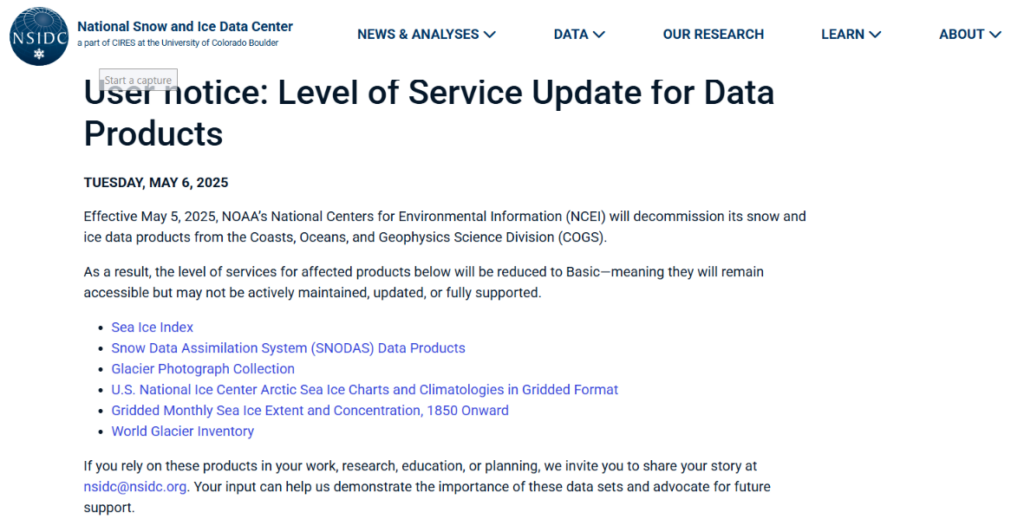I frequently post a summary of the Arctic section of the United States’ National Snow and Ice Data Center’s monthly review of the current state of the cryosphere. Here is the most recent edition.
However, this month I have some additional bad news to report. According to a May 6th “Level of Service Update for Data Products” from the NSIDC:
Effective May 5, 2025, NOAA’s National Centers for Environmental Information (NCEI) will decommission its snow and ice data products from the Coasts, Oceans, and Geophysics Science Division (COGS).
As a result, the level of services for affected products below will be reduced to Basic—meaning they will remain accessible but may not be actively maintained, updated, or fully supported.
- Sea Ice Index
- Snow Data Assimilation System (SNODAS) Data Products
- Glacier Photograph Collection
- U.S. National Ice Center Arctic Sea Ice Charts and Climatologies in Gridded Format
- Gridded Monthly Sea Ice Extent and Concentration, 1850 Onward
- World Glacier Inventory
If you rely on these products in your work, research, education, or planning, we invite you to share your story at [email protected]. Your input can help us demonstrate the importance of these data sets and advocate for future support.

I will certainly share my story with the NSIDC. If you are a resident of the US you may also wish to contact your local friendly neighbourhood politician(s) about the matter?
[Update – May 9th]Mark Serreze, Director of the National Snow and Ice Data Center, replied to my email and told me that:
We are acutely aware of the importance of the SII and Sea Ice Today. Millions of visits per year. High priority. We’re in the middle of discussions about to make sure that we have continuity.
Thanks for your support. Everything helps.
One of the less well known data products provided by the NSIDC is EASE-Grid Sea Ice Age.
I recently used that particular mine of essential cryospheric information to produce this educational YouTube video:
The video reveals the underlying reason for the “fast transition” of Arctic sea ice cover from thick multi-year ice to a reduced area of much more mobile young ice.
To be continued…
In an intriguing development “political scientist” Roger Pielke Jr. recently stated in a scurrilous New York Post op-ed:
Here’s some even more shocking news!
Tony Heller (AKA “Steve Goddard”) is also a big fan of NOAA’s climate data: